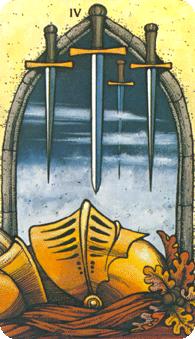The Four of Swords: The Confessio
(c) Cheryl Lynne Bradley 2003-7

"Vigilance, retreat, solitude, hermit's repose, exile, tomb and coffin. It is these last that have suggested the design."
A.E. Waite "The Pictorial Key to the Tarot", 4 of Swords
"In a church with a stained-glass window, the effigy of a knight lies full length upon his tomb. His hands are clasped together in prayer."
Eden Gray, "Complete Guide to the Tarot", Four of Swords
Most of us are familiar with the traditional Tarot imagery of the 4 of Swords, typically represented by a man in repose on a long table or altar, his hands clasped together in silent prayer, as if in eternal slumber. It was a common practice of the early Christians, and one that they held quite sacred, that the bodies of Christian martyrs should not be disturbed and that early church buildings were built over the tombs of the martyrs, no matter how difficult it might have been to achieve.
Martyrs were considered to be the Confessors of the Faith, they confessed their faith in Christ to the world and paid for this with their lives. Altars were placed above the tomb of the martyr and, once the altar was built, their final resting place came to be called a confessio. Sometimes the slab which covered the martyr's grave was at the same level with the sanctuary floor. The sanctuary is also called the presbyterium. Since the sanctuary was above the main floor of the church, the altar could be placed right above the tomb. People in the church had access to the confessio from the main floor and could view the relics through a grating called the fenestella confessionis. In some churches the fenestella has an opening through which brandea could be placed on the tomb. Brandea was a box containing portions of silk or cloth, which, after it had lain in contact with the martyr's remains, were treated as relics.
Relics and the bones of martyrs were thought responsible for many miracles and the practice of worshipping and collecting relics as spiritual currency flourished, as did the desecration of the martyr's tombs by those seeking relics. There did not seem to be any qualms about dismembering the bodies of the martyrs and spreading the pieces around. The relics were desired because they were thought to contain the essence of the saint or martyr's aura and therefore had power for liturgical and healing purposes. Pope Gregory I came up with the idea of brandea to stop the desecrations.
People believed that even touching the confessio was a blessing and a sanctification. The dust or mould that settled on the confessio was also considered a gift and they gathered it to carry home with them.
It was also very common practice for people to desire burial near the tombs of the martyrs. The belief being that when the souls of the martyrs were united to their bodies on the Judgment Day, anyone buried near them would accompany them and would be more readily accepted by God.

















